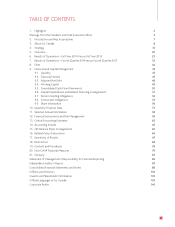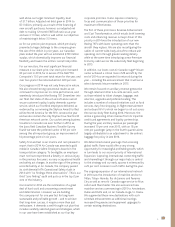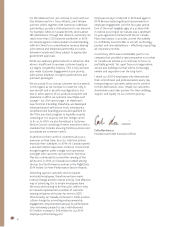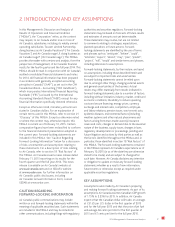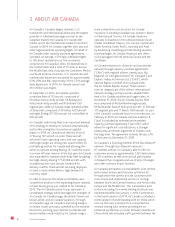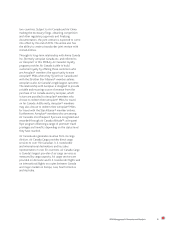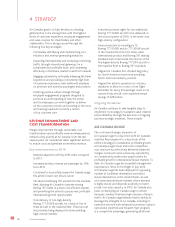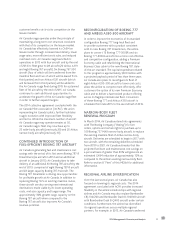Air Canada 2014 Annual Report Download - page 13
Download and view the complete annual report
Please find page 13 of the 2014 Air Canada annual report below. You can navigate through the pages in the report by either clicking on the pages listed below, or by using the keyword search tool below to find specific information within the annual report.
13
2014 Management’s Discussion and Analysis
PENSION
In December 2013, the Government of Canada
formally approved the Air Canada Pension Plan
Funding Regulations, 2014 (the “2014 Regulations”).
Air Canada maintains several pension plans, including
defined benefit and defined contribution pension
plans and plans providing other retirement and
post-employment benefits to its employees. As at
January 1, 2014, the aggregate solvency surplus in the
domestic registered pension plans was $89 million.
The next required valuations to be made as at
January 1, 2015, will be completed in the first half
of 2015 but, as described in section 9.7 “Pension
Funding Obligations” of this MD&A, they will not
impact the 2015 pension past service cost funding
obligations unless Air Canada opts out of the 2014
Regulations (described below), deciding instead to
fund its domestic registered pension plans pursuant to
normal funding rules. Based on preliminary estimates,
including actuarial assumptions, as at January 1, 2015,
the aggregate solvency surplus in Air Canada’s
domestic registered pension plans is projected to be
$780 million.
Air Canada is permitted to opt out of the 2014
Regulations and have past service payments in
respect of all Air Canada pension plans, collectively,
determined in accordance with normal funding rules.
Air Canada would consider opting out of the 2014
Regulations when the annual solvency deficit
payments under normal funding rules, which are
determined using deficit levels over three years, would
be less than $200 million and when there would
be a strong basis for confidence that the airline’s
de-risking strategy would make a future significant
deficit unlikely to re-occur. At December 31, 2014,
approximately 72.5% of the pension liabilities were
matched with fixed income products to mitigate a
significant portion of the interest rate (discount rate)
risk.
In the event that Air Canada opts out of the 2014
Regulations, based on the normal funding rules and
subject to the finalization of the preliminary estimate
of the pension solvency surplus of $780 million
at January 1, 2015, Air Canada’s pension solvency
payment would be approximately $90 million in 2015.
For a more detailed discussion on Air Canada’s
pension and related funding matters, please see
section 9.7 “Pension Funding Obligations” of
this MD&A.
INTERNATIONAL GROWTH
Air Canada is specifically focused on seeking new
international growth opportunities to generate
sustainable profit, with approximately 90% of
Air Canada’s planned growth in 2015 targeted to such
initiatives. Air Canada now has at its disposal more
cost-efficient aircraft, improved tools and processes
and other competitive attributes to profitably pursue
new international route opportunities. Air Canada also
has access to Canada’s wide portfolio of international
routes rights and Canada’s multi-ethnic demographic
profile provides the airline with further opportunities
to profitably capture demand for international travel.
These attributes combined with Air Canada’s powerful
brand franchise and industry-leading products and
services allow Air Canada to leverage its network and
benefit from the higher margins generally available in
international markets. The airline will also continue
to leverage its world-class hub at Toronto Lester B.
Pearson International Airport (“Toronto Pearson”) and
other Canadian hubs with the objective of increasing
global connecting traffic via Canada.
Key achievements in 2014
• Introduced mainline service from Toronto Pearson
to Milan and Tokyo-Haneda
• Introduced non-stop mainline service between
Toronto Pearson and Rio de Janeiro, reinforcing
Air Canada’s market-leading position as the only
carrier flying non-stop between Canada and South
America
• Introduced non-stop mainline service from
Toronto Pearson to Panama City, making it the
only Canadian network carrier operating between
Canada and Panama
• Introduced Air Canada rouge service from
Montreal to Nice, Toronto Pearson to Lisbon and
Toronto Pearson to Manchester
• Converted the airline’s routes from Vancouver
to Shanghai and Vancouver to Toyko-Narita to
787 Dreamliner service
• Introduced a series of new codeshare routes
with Air India to improve air travel connectivity
between Canada and India
• Concluded a memorandum of understanding
with Air China which remains subject to certain
conditions and which sets out the main principles
for a comprehensive revenue sharing joint venture
• Increased sixth freedom traffic
(international-to-international, including U.S.)
connecting at Air Canada major Canadian hubs
by 23% from 2013


